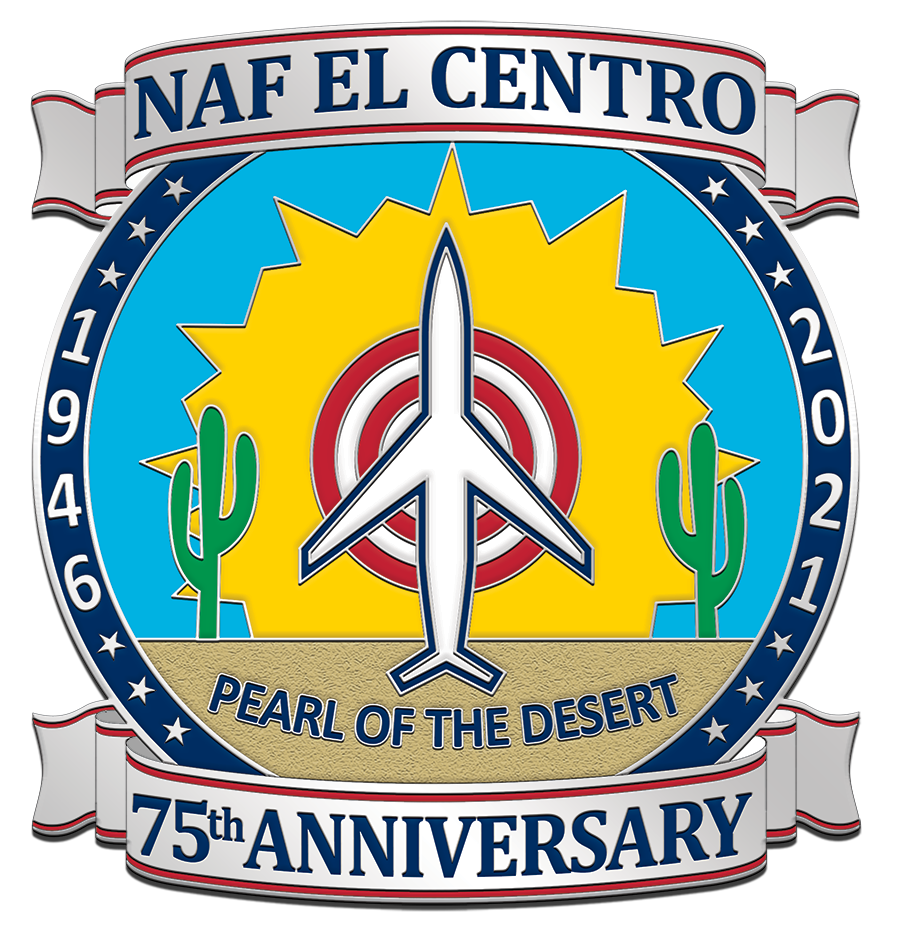 BRIEF HISTORY OF NAF EL CENTRO
BRIEF HISTORY OF NAF EL CENTRO
Following the attack on Pearl Harbor, the Navy granted the Marine Corps’ request to establish five air bases on the West Coast. Lt. Col. William Fox, USMCR was given this assignment and instructed to look in the Imperial Valley in California. One of the sites selected by Fox was El Centro. In his report to his superiors, he indicated that there was perfect flying weather, flat terrain and low winds. He also mentioned the summers could be especially warm. The site he selected was perfect for pre-combat training, development of tactical solutions and aerial gunnery practice.
The initial station comprised of two 4,500-by-150 foot parallel runways constructed by the Civil Aeronautics Administration. The Navy leased 943 acres and purchased 949 acres to start the facility. The installation was later expanded to 2,800 acres; the size it remains today. Additional construction on the fledging base started on May 15, 1942. Beyond the station area were skeet and rifle ranges, malfunction and turret ranges for gunnery practice, a rabbit range, a rocket range and a rocket ground school. Marine Air Base Defense Aircraft Group 43 arrived on January 1, 1943 and was the first unit to report to the base. MCAS El Centro was commissioned on July 23, 1943 with Lt. Col. Thomas J. McQuade the Commanding Officer.
Enlargement of the installation was necessary as the desirability of El Centro as a training base grew. Remnants of the construction are still visible in the concrete aprons around hangars 7 and 8. In its brief time as a Marince Corps Air Station, sixteen squadrons of fighter, bomber, and transport aircraft pilots and their ground crews were trained here. Post World War II, the facility was greatly reduced and on May 1, 1946 Naval Auxiliary Air Station El Centro was commissioned. From the commissioning until June of 1947, the facility was the storage pool for TD2 Devastator torpedo aircraft. In 1947, the Parachute Experimental Division moved from NAS Lakehurst, NJ to El Centro. The birth of parachute testing at the Pearl of the Desert had begun! In 1952, the Fleet Gunnery Unit was moved to El Centro as well. This was the precursor to the well-known “Top Gun” school. From 1947 to 1964 the Navy alongside the Air Force’s 6511th Parachute Development Test group operated from the southern ramp. In 1964 the southern part of the base was commissioned as the Naval Aerospace Recovery Facility. On July 1, 1973 NAAF El Centro and NARF El Centro were combined to form the National Parachute Test Range. The parachute mission ended for El Centro in 1979 when those components were transferred to Naval Weapons Center China Lake. On July 1, 1979, El Centro became a Naval Air Facility again.
In 1979, following a permanent detachment from VA-174 for maintenance duties, the base began fulfilling the role we see her in today; providing premier facilities to support the combat training and readiness of the Warfighter. In the 70 years of service, the men and women of NAF El Centro have been witness to the birth of safe and reliable aircraft ejection systems, parachute cargo delivery, basic and advanced flight training, aerial combat, and the means to support those systems. Space travel as we know it was made possible by the development of space recovery systems for the Mercury, Gemini, Apollo and Space Shuttle programs.
From the 1980s to today, NAF El Centro has become the premier center for the training of the aerial warfighter. Not only to U.S. Navy pilots come here to hone and perfect their skils, but aviators from our sister services and our allies train in the uniquely perfect flying conditions. The base remains a cornerstone of pilot production for the Naval Aviation Enterprise and is poised to grow and adapt for the airframes of the future.
LINKS TO VIDEOS ON OUR YOUTUBE CHANNEL OR PARTNER AGENCY CHANNELS
The El Centro Story
Minute of History: El Centro Plane Crash - Part 1 of 2
Minute of History: El Centro Plane Crash - Part 2 of 2
BD-0024 Douglas A3D (A-3) Skywarrior, BuNo 130353, Crash at NAF El Centro, October 1964